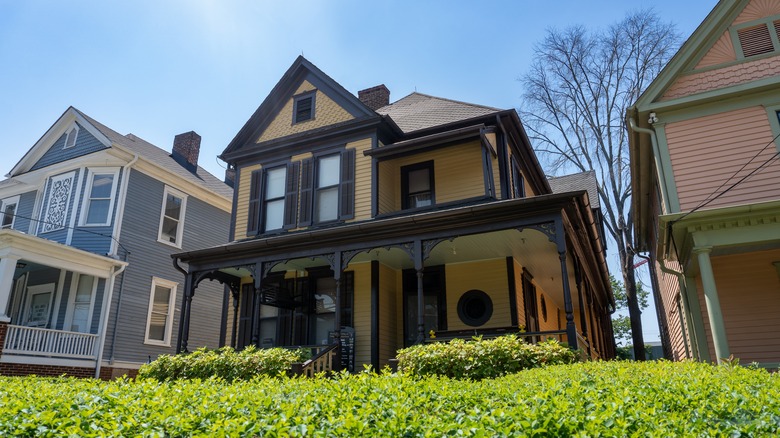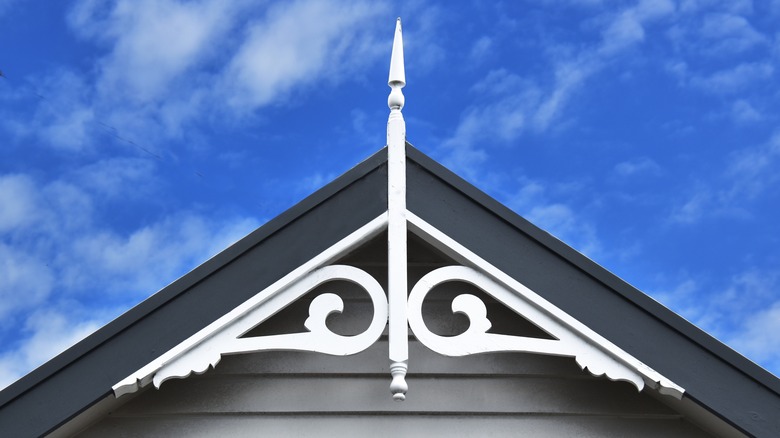What It Means If You See An Old Home With This Intricate Wooden Design
The minute you walked into that home you knew it was yours. What captured your attention was the intricate wood cutout paneling above doorways, on balustrades, and high up on the walls. You've never seen such creative ways to use wood to transform a ceiling! In fact, in a weird way, the decorative feature reminded you of a gingerbread house. And that's not surprising. What you're looking at is fretwork — fine wood detailing created using specialized carpentry techniques and tools, and it likely inspired the now-familiar gingerbread house design. Seeing fretwork in an American home means you're likely standing somewhere with a lot of history behind it, probably constructed during the Victorian era (roughly 1820 to 1914) when the ornamental design was at peak popularity — although this isn't the only time fretwork was popular in American interior design.
Fretwork has its origins in the spiral-filled lumber screens of Ancient Greek and Egyptian architecture, hand-carved geometric wooden partitions of 12th-century Middle Eastern buildings called mashrabiya, and the intricate timber grapevine trellises used in France in the same period. As the centuries wore on, fretwork designs became more elaborate and ornate, inspired by flora and fauna. The Victorian middle class in both England and America was particularly enamored with the architectural feature, the result of the popularity of fretwork-adorned chairs and other furniture pieces by famed carpenter Thomas Chippendale. It gave the illusion of privacy while letting light to filter into dim rooms and looked, well, pretty posh.
The history of fretwork in American architecture
Originally, people probably made fretwork with knives until, in the 15th century, the Germans invented the fine saw blade and the French invented a handle for it. The purpose-made scroll saw, also called a fret saw, was born! Still, it wasn't until well after the Industrial Revolution that a mechanized version, the precursor of the electric reciprocating saw, was invented. Today, most fretwork is manufactured in factories; designers create the patterns on computers and machinists cut the wooden planks with lasers. However, some hobbyists and professional woodworkers use electric scroll saws and work by hand.
Fretwork featuring Greek-Revival motifs (those distinctive square spirals) was popular in American architecture of the early 19th century, as the Enlightenment and Neoclassical style soared in popularity. The style would be revived by Beaux-Arts designers, who styled Ancient Greek and Roman-inspired buildings in the late 1800s through to the 1920s. In the American South, 18th and 19th-century homes featured fretwork on porches — the homes in New Orleans' Garden District are good examples. A little later, Victorian America's preoccupation with expert craftsmanship saw fretwork surge in popularity. Likewise, it's a prominent feature in Queen Anne style homes. Moses Younglove Ransom is credited with inventing America's most often-seen fretwork style, which he dubbed (and patented in 1885) 'Moorish fretwork.'
Identifying and restoring fretwork in a historic home
You can spot fretwork in a historic home before walking in the door. Porch and balcony railings on period facades are full of it; so are gables, cornices, friezes, and Arts and Crafts balustrades. Inside a house, look for fretwork radiator covers, window frames, fireplace mantles (especially in Federal style homes), stairways, and the fixed screens and room dividers of the Aesthetic period. Famous fretwork-filled buildings include the Chippendale-fretwork-adorned Henry Clay State Dining Room; the Japan-inspired paneling in The Sinatra House; the Herman House in Long Island, with its abundant Victorian-era decorations; and the Purcell-Cutts House in Minnesota with its two sawed-wood entryway panels.
If you're restoring fretwork, find a professional carpenter experienced in period restoration rather than trying to do it yourself. If you know fretwork once adorned door arches or stairwells in your house and want to put it back, many of the best places to shop for vintage furniture also stock antique decorative designs sourced from actual Victorian-era properties. Alternatively, find a local woodworker skilled in fretwork to craft bespoke designs. Prefer a contemporary vibe? There are all kinds of stunning DIY ceiling designs that will elevate any room in your home available online and in hardware stores. You can get them to adorn your walls, too. The pre-cut panels are typically made of lightweight wood or PVC, and they stick easily to your wall using construction adhesive and brad nails.

